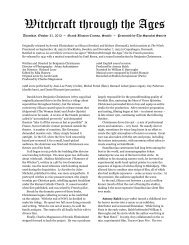Experimental Memoria II: Robert Breer - The Sprocket Society
Experimental Memoria II: Robert Breer - The Sprocket Society
Experimental Memoria II: Robert Breer - The Sprocket Society
You also want an ePaper? Increase the reach of your titles
YUMPU automatically turns print PDFs into web optimized ePapers that Google loves.
Breathing (1963) b/w, 5 min.<br />
Awards: NY Film Festival; London Film Festival; Tours Film Festival<br />
“<strong>Breer</strong>’s unpredictable lines flow forth naturally with an assurance and a serenity which are the signs<br />
of an astonishing felicity of expression.” – A. Labarthe, Cahiers du Cinema<br />
“[In Breathing,] <strong>Breer</strong>’s animation explores the theme and variation of the drawn line: a line<br />
in constant movement and transformation. With a very sketchy style, he demonstrates how a simple,<br />
abstract image can fill and satisfy the imagination of the film viewer.” – MOMA Circulating Film<br />
Library Catalog<br />
“I work in strange little rooms and places, I like to do that...to get myself a room someplace<br />
and close to the door and sort of work in there.... So, I had a sign for making Breathing, which<br />
involved making thousands of drawings over a period of a couple of months – and I had a sign which<br />
was going to be the title of the film, for a while – I’ll be damned if I can remember it exactly – I think<br />
it was: THIS FILM IS WHAT IT IS WHAT IT IS WHAT IT IS WHAT IT IS – and had the sign around<br />
and that was a reminder for me, as a kind of discipline that I didn’t refer to anymore after I wrote it,<br />
but it was there to remind me that I was making a really concrete film; I wasn’t going to digress; I<br />
was going to keep on making ‘direct’ film. So it is a kind of compulsion to define my limits.” – R.B.<br />
interviewed in Film Culture no. 56-57 (1973)<br />
Fist Fight (1964) color, 9 min.<br />
Music: from Originales by Karlheinz Stockhausen<br />
Awards: NY and London film festivals; Special Mention, Ann Arbor Film Festival, 1965<br />
“Fist Fight is a rapid-fire onslaught of images in which myriad animation techniques<br />
including collage, cartoon, and punched holes. Set to the sound of Karlheinz Stockhausen’s<br />
Originale, which combines ambient sound and disparate instrumentation, Fist Fight is a chaotic<br />
barrage of single frame images that combine in a humorously sly way. Unlike any of <strong>Breer</strong>’s other<br />
films, Fist Fight is also partly autobiographical. <strong>Breer</strong> scrambles still images – photographs of his<br />
family and friends – with fragments of cartoons, letters, fingers, mice, and other assorted objects.<br />
<strong>The</strong> film is articulated in bursts defined by sections of blackness, creating a strong tension between<br />
the lives depicted in the photographs and the brilliant explosion of imagery." – MOMA Circulating<br />
Film Library Catalog<br />
“<strong>The</strong> personal material blends into the animations and fragments without assuming a<br />
privileged emphasis. At times it seems as if they were not personal pictures at all, but simply the<br />
most convenient photographs for a film intensely determined to explore further ambiguities of<br />
stillness and motion, painterly surface and illusory depth.” – P. Adams Sitney, Visionary Film<br />
Beginning in January 1964, Karlheinz Stockhausen spent six months in the US, teaching at<br />
the University of Pennsylvania and doing a concert tour. During his stay, he befriended the<br />
pioneering “Happenings” artist Allan Kaprow, who secured Stockhausen’s permission to stage a New<br />
York performance of Originale, so long as it “avoid[ed] a repetition of the style and effects of the<br />
première in Cologne [in 1961].” Kaprow recruited 45 people from the New York radical avant garde<br />
arts and music scenes, including Alan Ginsberg and several members of Fluxus (who had actually<br />
demonstrated against Stockhausen in front of earlier concerts in NY).<br />
<strong>The</strong> event, described by one participant as “a big colorful circus,” was performed on several<br />
stage levels. It included barking sheepdogs and a dancing monkey originally intended for the<br />
original Cologne performances but not realized due to “opposition.” Percussionist Max Neuhaus



